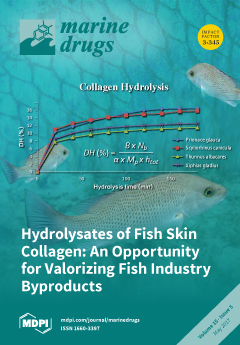In this study, we investigated the effect and mechanism of
Undariopsis peterseniana, an edible brown alga, on hair growth. The treatment of vibrissa follicles with
U. peterseniana extract ex vivo for 21 days significantly increased the hair-fiber lengths. The
U. peterseniana extract
[...] Read more.
In this study, we investigated the effect and mechanism of
Undariopsis peterseniana, an edible brown alga, on hair growth. The treatment of vibrissa follicles with
U. peterseniana extract ex vivo for 21 days significantly increased the hair-fiber lengths. The
U. peterseniana extract also significantly accelerated anagen initiation in vivo. Moreover, we found that
U. peterseniana extract was able to open the K
ATP channel, which may contribute to increased hair growth. The
U. peterseniana extract decreased 5α-reductase activity and markedly increased the proliferation of dermal papilla cells, a central regulator of the hair cycle. The
U. peterseniana extract increased the levels of cell cycle proteins, such as Cyclin D1, phospho(ser780)-pRB, Cyclin E, phospho-CDK2, and CDK2. The
U. peterseniana extract also increased the phosphorylation of ERK and the levels of Wnt/β-catenin signaling proteins such as glycogen synthase kinase-3β (GSK-3β) and β-catenin. These results suggested that the
U. peterseniana extract had the potential to influence hair growth by dermal papilla cells proliferation through the activation of the Wnt/β-catenin and ERK pathways. We isolated a principal of the
U. peterseniana extract, which was subsequently identified as apo-9′-fucoxanthinone, a trichogenic compound. The results suggested that
U. peterseniana extract may have a pivotal role in the treatment of alopecia.
Full article






